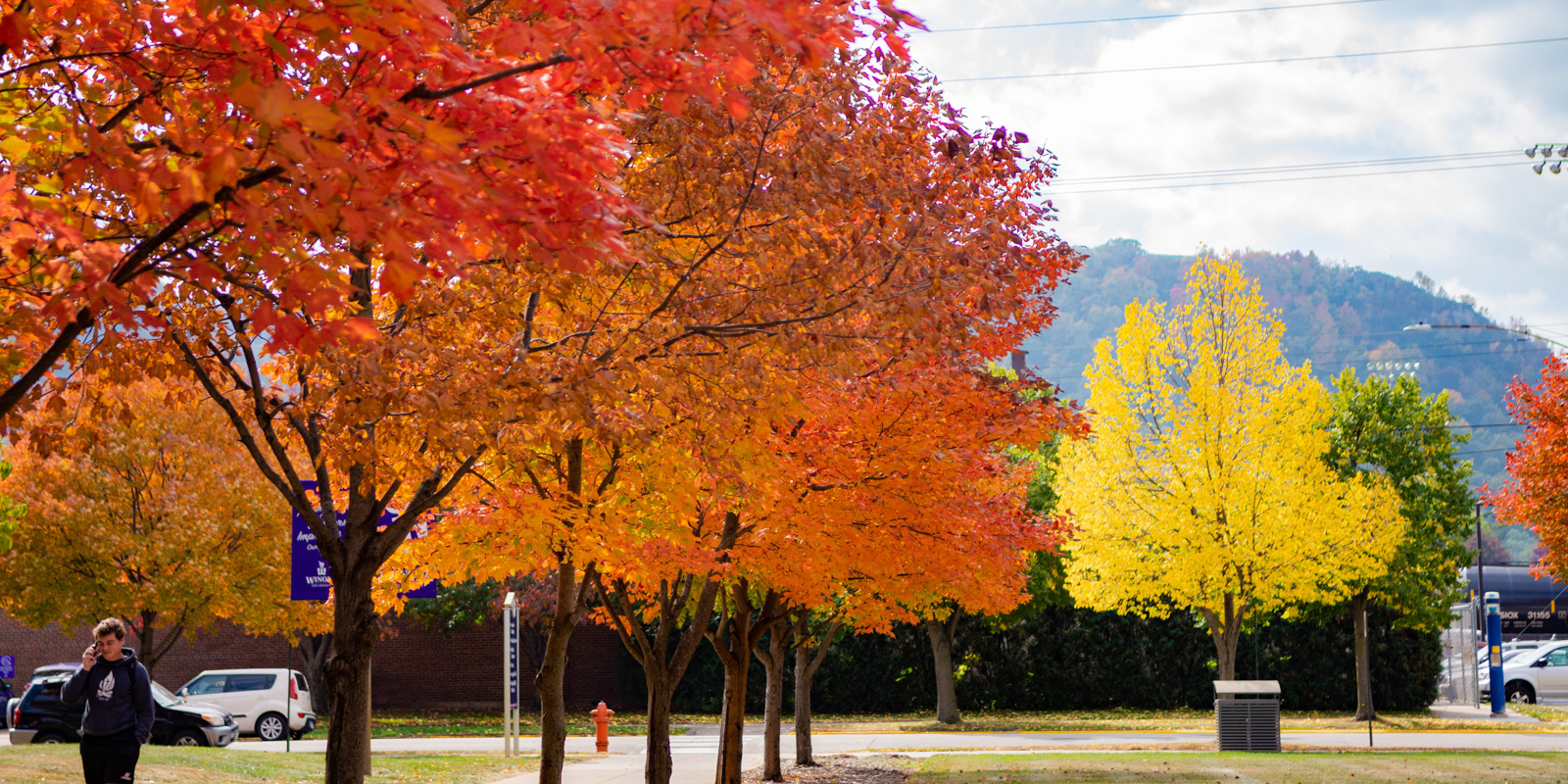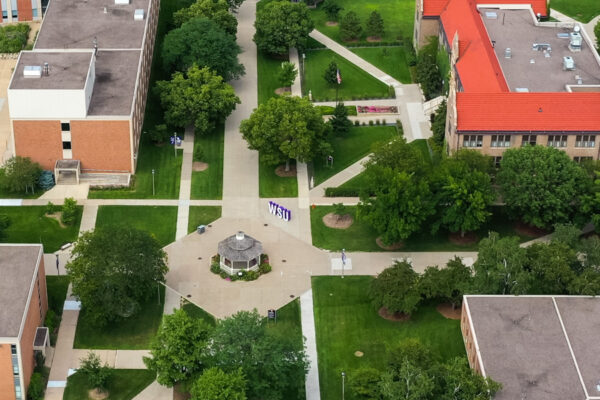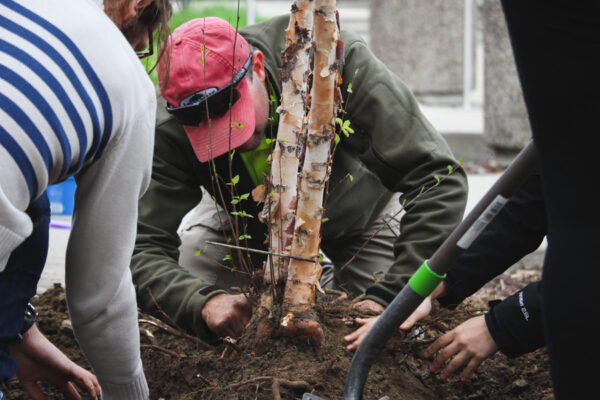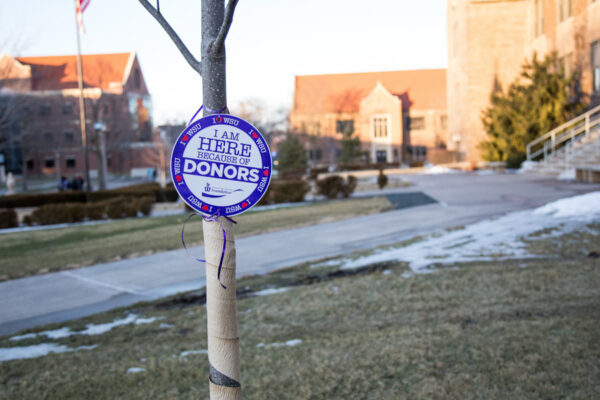
Landscape Arboretum
Over 125 acres of campus and nearby forested bluffs make up the Landscape Arboretum at Winona State University.
The Arboretum was established to support public enjoyment, education, recreation, and scientific study.
The Arboretum serves as an important educational tool for student, faculty and community learning, research, and development. This resource models sustainable and ethical land use policies and practices to our campus community and visitors throughout the region.
Our campus arboretum is in the works of becoming a regional arboretum, featuring trees and plants native to the southeastern Minnesota region. Plant material is labeled with both their scientific and popular names and features a host of additional information accessible by smartphone via a QR code.
Most species of trees native to Minnesota are already available for public enjoyment. The campus is also adorned with native and commercial species of flowers and grasses in addition to several memorial gardens.
Tree Campus Higher Ed is a national program that honors universities and their leaders for promoting healthy trees and engaging students and staff in the spirit of conservation.
To obtain this distinction, WSU met the 5 core standards for sustainable campus forestry required by Tree Campus Higher Ed, including:
- establishment of a tree advisory committee
- evidence of a campus Tree Care Plan (PDF)
- dedicated annual expenditures for its campus tree program
- an Arbor Day observance
- the sponsorship of student service-learning projects

Arbor Day is celebrated annually on the last Friday in April.
There are a variety of events hosted around Arbor Day, from giving away tree seedlings to outdoor projects and poems.
Tours can be tailored to your interests or educational purposes. The tour may include descriptions of trees and gardens as well as landscaping plans at WSU.
You can also learn more information about trees and plants you might want to plant at home, hear about current issues with invasive pests or plants and get your personal tree and garden questions answered.
Tours are open to WSU classes, the public, school groups, gardeners, youth groups and more.
To arrange a guided tour, contact the Landscape Arboretum Director at 507.457.5045.
Bring your smartphone and access more information on labeled trees via the QR codes on tree signage.
You can also view a self-guided campus tree tour.
As a volunteer you’ll help:
- Plant and maintain the beauty of the Landscape Arboretum
- Give tours of the landscape arboretum
- Put on Arbor Day celebrations and other events and activities planned by the WSU Arboretum and Land Stewardship Committee.

To become a volunteer, email the Volunteer Application Form (PDF) to the Landscape Arboretum Director at nathan.anderson@winona.edu.
Before you begin any volunteer work, you’ll need to complete the Arboretum Volunteer Waiver (PDF).
Apply for Volunteer Coordinator
We are seeking a motivated, qualified volunteer to be the Volunteer Coordinator for the Friends of the Landscape Arboretum.
If you are interested in becoming a volunteer, send an email request for the Volunteer Coordinator Application form to the Landscape Arboretum Director at 507.457.5045.
The Friends of the Landscape Arboretum Volunteer Coordinator will develop and coordinate a volunteer program for the Landscape Arboretum in accordance with the Volunteer Coordination Program for the Friends of the Landscape Arboretum.
This is an unpaid, volunteer position that reports to, and coordinates with, the All-University Arboretum and Land Stewardship Committee and the Arboretum and Land Stewardship Director of Winona State University.
Volunteers are not eligible for compensation, workers’ compensation, employee benefits, or travel expenses. Volunteers are subject to reference and background checks, compliance with the policies and procedures of the Minnesota State Colleges and Universities, signing a Waiver, Release, and Indemnification Agreement, and completing orientation and training.
- Communicate the vision of the Arboretum and the important role of the Friends of the Arboretum
- Consult with the All-University Arboretum and Land Stewardship Committee and the Arboretum Director regarding volunteer needs and requirements for upcoming Arboretum activities and events
- Promote the Friends of the Arboretum and coordinate recruitment of new volunteers with outreach to WSU and the Winona-area community through the Arboretum website, media (i.e. email, news releases, Facebook etc.) and university and community organizations
- Coordinate the volunteer application review and approval process; respond to inquiries about volunteer opportunities and submitted applications in a timely, hospitable manner
- Ensure that all volunteers complete and submit the approved and required waivers, release and indemnification agreements
- Coordinate with the Facilities staff to maintain paper and electronic files for all volunteer activities and individual volunteers, including volunteer activity descriptions, volunteer applications, signed waivers, releases and indemnification agreements, sign-in sheets or attendance rosters
- Develop and implement a comprehensive volunteer program for the recruitment, selection, training, evaluation and acknowledgement of Arboretum volunteers
- Work within a budget as assigned by the Committee
- Self-starter and able to work independently with minimal direction
- Attention to detail and excellent problem-solving capabilities
- Flexible collaborator, ready to contribute and adjust as required
- Ability to build strong relationships with new people and the organization
- Excellent time management and organizational skills
- Experience with and access to a personal computer, the Internet, and Microsoft Office Suite
- Personable and confident communicator who is patient and positive at all times
- Interest in environmental issues is an asset
- Preference given to applicants with prior experience working with volunteers
Estimated average of 6-8 hours per week, depending on the season and volunteer activities scheduled.
The Volunteer Coordinator work schedule is flexible, except for scheduled volunteer activities and Arboretum Committee meetings.
The work environment will include:
- Indoors
- Lifting
- Outdoors
- Working individually
- Sitting
- Working as part of a team
- Standing/Bending
It may also include working with children.
The successful candidate for this position will benefit by:
- Providing leadership through volunteer programming, to develop the WSU Arboretum as a “living laboratory and classroom” for student and faculty research as well as for public enjoyment, recreation and education within the region
- Gaining valuable experience establishing campus and community connections benefiting the WSU Arboretum
- Learning about and contributing to sustainable horticultural and ethical land stewardship practices on the WSU campus
That’s where the Arboretum’s donors, memorials, tributes, grants, and bequests help create the margin of excellence needed for this educational undertaking.
It’s the generosity of individuals, families, organizations, businesses, and voluntary organizations of every type that make the difference in helping fund the unique and special features of Winona State’s Arboretum.

You can learn more about contributing to the WSU Landscape Arboretum by calling 507.457.5020 or addressing inquiries to:
WSU Landscape Arboretum
Winona State University
University Advancement Office, Somsen Hall 204
Winona, MN 55987
Help the WSU Landscape Arboretum grow with a tax-deductible gift and join WSU’s community of learners improving our world.
Friends of the Arboretum
The Landscape Arboretum recognizes these individuals as Friends of the Arboretum. Their contributions help to create the beautiful campus that students and faculty appreciate each day.
- Susan Baloun (in memory of Judy and Charles Schlawin)
- The Family and Friends of Brooke Baures (in memory of Brooke Baures)
- Delta Phi Epsilon (in memory of Nicole Zanoni)
- Facilities Staff (in honor of Heidi and Kevin Ryan)
- The Family of Derek Harms (in memory of Derek Harms)
- Tim and Susan Hatfield
- Gennell Iverson
- Sandy and Hilary Melville (in memory of Austin Melville)
- Sigma Sigma Sigma (in memory of Pam Koelsch)
- Steve Morrison (in memory of Diane Morrison)
- Phi Theta Chi Sorority (in memory of sorority sisters)
- Amy Welch and Friends
- WSU Faculty
- WSU Students
- Kenny Wynia
The Friends of the Arboretum provide everlasting education through donations to create the living outdoor classroom our community loves.
In Memory of Derek Harms
Derek Harms attended WSU from August 2015 – April 2018. Derek is missed immeasurably but his memory lives on through WSU scholarships (The Derek Harms Leadership Award and an OERC Travel Award) and 3 beautiful birch trees on campus dedicated in his name to commemorate his love of nature and the outdoors.
It is his family’s hope that Derek’s friends and mentors come together here and find inspiration in this tranquil and meaningful setting.
Derek’s energy and warmth could light up any setting, and his family and friends lovingly remember his creativity, intelligence, and his kindness.
In his hometown of Barrington, Illinois, he showed talent and leadership in numerous clubs, activities and sports, earning varsity letters in Track and Field. He was always drawn to nature, and traveled with his family to local, regional and national parks, from the Everglades to the Redwoods.
At WSU, Derek excelled in his studies and also savored Winona’s scenic settings, traveling on OERC excursions and sharing his climbing and paddling skills through their community programs. He hosted a live music show on KQAL, played on WSU’s Ultimate Frisbee team and studied abroad in New Zealand and Australia with the Pacific Challenge.
In his junior year at WSU, Derek was a Commercial Recreation major with a Communications minor. He had detailed plans for his future and legions of loyal friends, when he perished in a snowboarding accident on April 8, 2018.
Other donations were made in Derek’s memory to:
- Sierra Club
- National Parks
- The National Arbor Day Foundation
- National Eagle Center in Wabasha, MN (for eagle care)
Derek’s family has also created arbor memorials in his home state of Illinois:
- A bench surrounded by 3 dedicated Swamp White Oaks installed at Citizens Park in Barrington
- The Riverwoods Scenic Overlook at Grassy Lake Forest Preserve which is supported by the Derek Harms Endowed Fund and the Lake County Forest Preserve